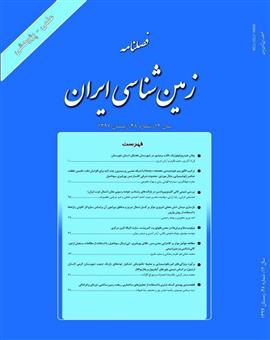بازسازی میدان تنش محلی امروزی مؤثر بر گسل شمال تبریز و مناطق پیرامون آن براساس سازوکاز کانونی زلزله¬ها با استفاده از روش وارون
محورهای موضوعی :احد نوری مخوری 1 , بهنام رحیمی 2
1 - دانشگاه فردوسی
2 - دانشگاه فردوسی
کلید واژه: جدایش تنش گسل شمال تبریز مکانیسم کانونی زلزله میدان تنش. ,
چکیده مقاله :
در این مطالعه، میدان تنش زمین ساختی امروزی مؤثر بر گسل شمال تبریز و نواحی پیرامون آن با استفاده از 37 سازوکار کانونی زلزله های جمع آوری شده از منابع مختلف، بازسازی شده است. برای تعیین ماهیت سازوکار کانونی زلزله ها و دامنه تغییرات ماهیت آن ها در رژیم های مختلف زمین ساختی از نمودارهای مثلثی استفاده شده است. ماهیت سازوکار این داده ها از رژیم امتدادلغزی تا راندگی تغییر می کند. برای به دست آوردن تنسورهای تنش تقلیل یافته ای که بیشترین تعداد داده ها در آن شرکت کنند و میدان های بازسازی شده، پوشش کاملی نسبت به تنش های مؤثر بر منطقه داشته باشد، فرایند جدایش تنش ها برروی داده ها برای جداسازی رژیم های زمین ساختی متفاوت از سیستم چند مرحله ای اعمال شد. نتایج تحلیل وارون و جدایش داخلی داده ها، نشان می دهد در این منطقه سه سامانه تنش عمل می کنند. بهطور جالب توجهی هر سه سامانه تنش دارای جهت فشارش افقی در جهت شمال غرب-جنوب شرق تا شمال شمال غرب-جنوب جنوب شرق هستند. جهت بیشینه فشارش در هر کدام از رژیم های تنش اول، دوم و سوم به ترتیب 329/09، 310/28 و 138/03 می باشد.
In this research, present-day tectonic stress field affecting North Tabriz Fault and surrounding areas was reconstructed by using 37 compiled earthquakes focal mechanism from various sources. Triangle diagrams were used to determine the sense of the earthquakes focal mechanism. The sense of these data varies from strike-slip to thrust regime. Stress separation process was applied on data set for separation of the various tectonics regimes from a poly-phase system to obtain reduced stress tensors. This was done because most of the data participated in them and reconstructed stress fields completely cover the stresses affecting the region. The results of inversion analysis and internal separation of the data set show three stress regimes acting in this region. Considerably, all three stress regimes have a horizontal pressure stress with NW-SE to NNW-SSE trend. The direction of maximum pressure in each first, second and third regimes is 09/329, 28/310 and 03/138, respectively. In this research, present-day tectonic stress field affecting North Tabriz Fault and surrounding areas was reconstructed by using 37 compiled earthquakes focal mechanism from various sources. Triangle diagrams were used to determine the sense of the earthquakes focal mechanism. The sense of these data varies from strike-slip to thrust regime. Stress separation process was applied on data set for separation of the various tectonics regimes from a poly-phase system to obtain reduced stress tensors. This was done because most of the data participated in them and reconstructed stress fields completely cover the stresses affecting the region. The results of inversion analysis and internal separation of the data set show three stress regimes acting in this region. Considerably, all three stress regimes have a horizontal pressure stress with NW-SE to NNW-SSE trend. The direction of maximum pressure in each first, second and third regimes is 09/329, 28/310 and 03/138, respectively.
